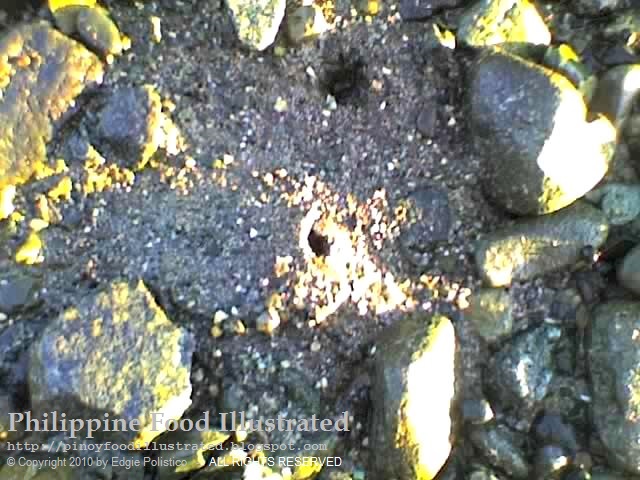linabog nga tilapia - /li-na-bóg nga ti-láp-ya/ Ilonggo, Cebuano, and Boholano dish) [n.] Tilapia fish in thick and spicy hot coconut milk.
Fresh tilapias are gutted and scaled
Linabog is an old-time Visayan seafood delicacy.
Originally, it uses meat from cartilaginous fish, such as pagi (ray) or iho (shark). The meat of dugong
(manatee), butanding (whale shark),
and balyena (whale) are also favored
when available. If not available, slimy freshwater fish is used, like the hito (catfish) or the haluan (mudfish).
The ingredients
When Visayans migrated to Mindanao at the height of the “Land of Promise” campaign
in the 1970s, they brought along with them the traditional Visayan seafood dishes
that included linabog. This explains
why linabog is also found in
Mindanao.
The ingredients are prepared and ready.
In the olden days, the pagi or iho was cooked into inun-onan (boiled in vinegar) without any condiment, as it was merely a process of preserving the catch to last for days without getting rotten. Later on, the inun-onan evolved with condiments introduced to the islands. The thick coconut
cream was used as a desirable ingredient and thought to be a natural protection from possible
food poisoning. Hot spice is also added to mask any nasty taste. What used to be thrown
away, eventually became a delectable delicacy.
The fish are cooked in vinegar with garlic and salt to taste. Just the way you cook paksiw na isda. Banana leaves are used to wrap each fish to keep the fishes from sticking to each other. The leaves also add aroma to the dish.
When boiled and cooked, excess vinegar is drained.
Now
that the Philippine and International Laws on Marine Wildlife Protection
prohibits the capture and consumption of the sea fish mentioned above, the
tradition of cooking the original linabog
shunned away the locals from savoring their old-time favorite linabog. But the taste of linabog lingers making the locals keep on longing for it. When pagi and
iho are not available, they resort to
hito or haluan. Later on, tilapia
is also used.
Cooking oil is added and brought to boil. The fish are fried well until crisp with those bones and fins on the edges would easily brittle.
Excess oil is drained right away after frying, or the fishes are removed from the oil.
Braising
the fish first in vinegar with salt and spices transforms “nasty” to “tasty.” It
removes the nasty fishy odor of the fish. Cooking is exactly the same way as you
cook paksiw na isda. In my recipe, I made the twist of frying the fish after braising them in vinegar with
condiments to attain the crispiness of the skin and edges of the fish, which is a favorite
of mine when it comes to tilapia.
Chewing the crisp-fried bones is nice and tasty. It also eliminates the hassle
of picking those tiny bones around the edges, which I often feared might prick
my throat if I accidentally swallowed them.
All the spices are sauteed until they caramelize then added with some water, simmered for awhile, then coconut cream is added (below).
Visayans are known to be fond of using creamy coconut milk in their seafood delicacies. Almost all Visayan seafood cooked with coconut cream or coconut milk are my favorites, among them are the tinunoang kinilaw (fish ceviche in coconut cream), the tinunoang kinhason (shellfish in coconut milk), and linabog.
| Curry powder |
Hot chili pepper
Salt
Sibuyas dahon (chive)
I was inspired by the sinugno of Quezon province that I added pechay leaves (in place of mustasa)
in my recipe. Chilies are not strange to Visayans. They use it to spice in many of
their dishes. They even have a dish called halang-halang
for that. They also squeeze chilies in kinilaw.
Here’s my version of linabog and enjoy cooking and dining with my fellow Visayan’s comfort food. This will make linabog continue to live on - in a new form
The crisp fried tilapias are arranged on top the savory spicy coconut sauce. To eat, flake the fish, dip or combine it in the sauce, and savor every bite.
See Index of Entries here.
If you liked this post, share it.
Let us know your opinion on the subject. Feel free to comment in the comment section, below. We need to know what you think.
Tell us what other topics you want us to write, share, and discuss.
Related posts:
A fully illustrated recipe by Edgie Polistico
All photos by Edgie Polistico posted in this blog are copyrighted. ALL RIGHTS RESERVED.
Continue to follow my blogs. You can also follow and learn more by joining us in our Facebook group. Have more bits and pieces about our kind of food, ingredients, and ways of cooking, dining, and knowing food culture across the 7,641 islands of the Philippines. I will search for more and continue to share my findings. It is my pleasure to rediscover the known and least known things or the unheard ones and put them here for everyone to find, learn, and treasure.
Encouragement and enthusiasm are not enough. I also need moral support, prayers, and anything else that can uplift my spirit and keep my good reasons. Keep them coming. All I know is that I am happy with what I am sharing and giving away. If you are pleased and happy with what I am doing, just smile and please share the happiness. Keep sharing and include to share the PHILIPPINE FOOD ILLUSTRATED. I feel energized when my blog becomes one of the reasons why you are happy and smiling.
Edgie Polistico
For more about Filipino food, see this Philippine Food, Cooking, and Dining Dictionary. It is OPEN and FREE.







